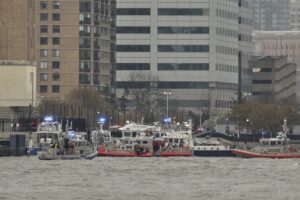NEW YORK — Parts of New York finally caught a break Sunday after a storm spent days dumping a potentially record-setting amount of snow on cities and towns east of Lake Erie and Lake Ontario.
The commercial vehicle ban remains in place on Route 219 from Route 39 to I-90 as the road remains closed.
On I-81 from exit 33 to the Canadian border, trucks are still required to use the right lane only.
DOT has lifted its full commercial vehicle ban at the following locations:
- Interstate 190 – Route 62 to I-90.
- Interstate 290 – full length.
- Interstate 990 – full length.
- Route 33 – expressway portion only.
- Buffalo Skyway Route 5 – full length.
- Route 400 – full length.
The New York Thruway has reopened to all traffic and there are no commercial vehicle restrictions at this time with the following exceptions:
- Thruway (I-90) exit 55 (Lackawanna) remains closed to all traffic to support the closure of Route 219.
- Additionally, exit 56 (Blasdell) and exit 57 (Hamburg) remain closed to commercial traffic to facilitate cleanup efforts in these areas.
Thruway Authority personnel continue cleanup efforts following the significant lake effect storm with 657 operators and supervisors ready to respond statewide. Thruway has shifted and deployed additional staff and equipment from its New York, Syracuse, and Albany Divisions to support snow and ice operations and snow removal efforts in Western New York. Deployed resources include operators and supervisors, mechanics, large plow trucks, and large snowblowers.
Many businesses in the hardest-hit areas remained closed, but highways reopened and travel bans in many areas were lifted, though bands of lake-effect snow were expected to bring up to 2 feet by Monday morning in some parts of the state that were largely spared in earlier rounds.
“This has been a historic storm. Without a doubt, this is one for the record books,” New York Gov. Kathy Hochul said at a briefing Sunday.
Snow began falling Thursday in towns south of Buffalo. By Saturday, the National Weather Service recorded 77 inches in Orchard Park, home to the NFL’s Buffalo Bills, and 72 inches in Natural Bridge, a hamlet near Watertown off the eastern end of Lake Ontario.
Similar multiday storms have brought bigger snowfall totals than that in the past to New York, but the ferocity of the storm on Friday appeared to threaten the state’s record for most snowfall in a 24 hour period: the 50 inches that fell on Camden, New York, on Feb. 1, 1966.
National Weather Service meteorologist Jason Alumbaugh, who is based in Buffalo, said it was too early to say whether any of this year’s snowfalls exceeded that record.
Hochul is asking for a federal disaster declaration for the affected areas, which would potentially unlock some aid. She said teams were checking on residents of mobile home parks in areas that got enough snow to potentially crumple roofs.
Due to the heavy snowfall, a Sunday football game between the Buffalo Bills’ and Cleveland Browns was moved to Detroit.
New York is no stranger to dramatic lake-effect snow, which is caused by cool air picking up moisture from the warmer water, then releasing it in bands of windblown snow over land.
This month’s storm is at least the worst in the state since November 2014, when some communities south of Buffalo were hit with 7 feet (2 meters) of snow over the course of three days, collapsing roofs and trapping drivers on a stretch of the New York State Thruway.
The Associated Press is an independent global news organization dedicated to factual reporting. Founded in 1846, AP today remains the most trusted source of fast, accurate, unbiased news in all formats and the essential provider of the technology and services vital to the news business. The Trucker Media Group is subscriber of The Associated Press has been granted the license to use this content on TheTrucker.com and The Trucker newspaper in accordance with its Content License Agreement with The Associated Press.








